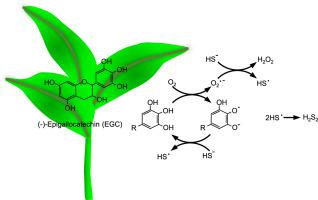Redox Biology ( IF 10.7 ) Pub Date : 2020-09-18 , DOI: 10.1016/j.redox.2020.101731 Kenneth R Olson 1 , Austin Briggs 1 , Monesh Devireddy 2 , Nicholas A Iovino 1 , Nicole C Skora 1 , Jenna Whelan 1 , Brian P Villa 1 , Xiaotong Yuan 3 , Varun Mannam 3 , Scott Howard 3 , Yan Gao 2 , Magdalena Minnion 4 , Martin Feelisch 4

|
Matcha and green tea catechins such as (−)-epicatechin (EC), (−)-epigallocatechin (EGC) and (−)-epigallocatechin gallate (EGCG) have long been studied for their antioxidant and health-promoting effects. Using specific fluorophores for H2S (AzMC) and polysulfides (SSP4) as well as IC-MS and UPLC-MS/MS-based techniques we here show that popular Japanese and Chinese green teas and select catechins all catalytically oxidize hydrogen sulfide (H2S) to polysulfides with the potency of EGC > EGCG >> EG. This reaction is accompanied by the formation of sulfite, thiosulfate and sulfate, consumes oxygen and is partially inhibited by the superoxide scavenger, tempol, and superoxide dismutase but not mannitol, trolox, DMPO, or the iron chelator, desferrioxamine. We propose that the reaction proceeds via a one-electron autoxidation process during which one of the OH-groups of the catechin B-ring is autooxidized to a semiquinone radical and oxygen is reduced to superoxide, either of which can then oxidize HS− to thiyl radicals (HS•) which react to form hydrogen persulfide (H2S2). H2S oxidation reduces the B-ring back to the hydroquinone for recycling while the superoxide is reduced to hydrogen peroxide (H2O2). Matcha and catechins also concentration-dependently and rapidly produce polysulfides in HEK293 cells with the potency order EGCG > EGC > EG, an EGCG threshold of ~300 nM, and an EC50 of ~3 μM, suggesting green tea also acts as powerful pro-oxidant in vivo. The resultant polysulfides formed are not only potent antioxidants, but elicit a cascade of secondary cytoprotective effects, and we propose that many of the health benefits of green tea are mediated through these reactions. Remarkably, all green tea leaves constitutively contain small amounts of H2S2.






































 京公网安备 11010802027423号
京公网安备 11010802027423号